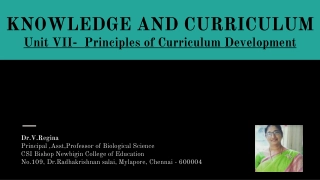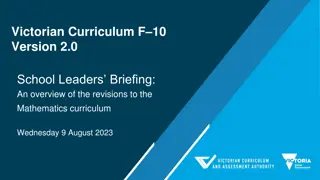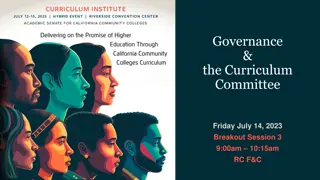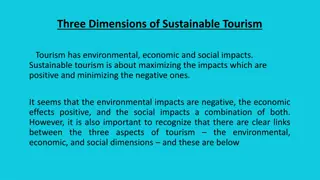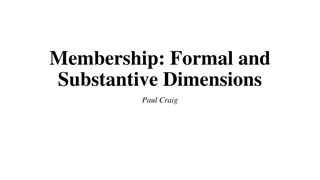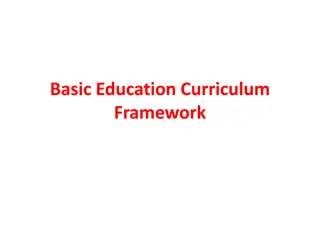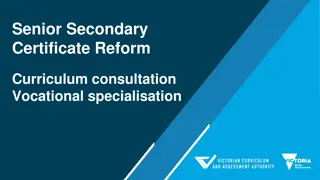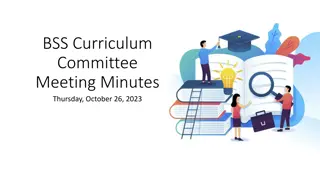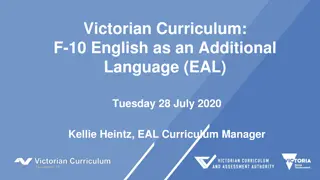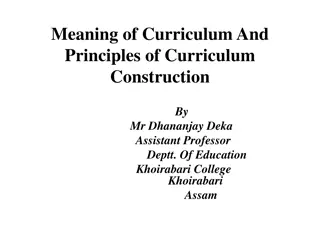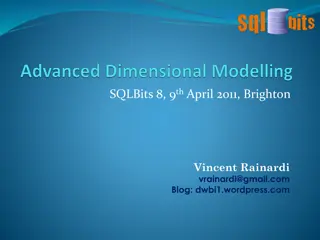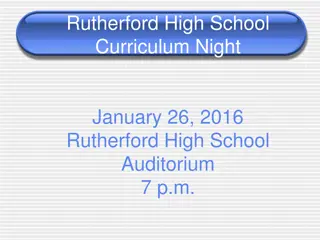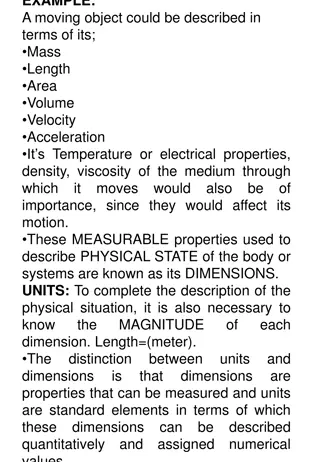Dimensions of Curriculum in Education: An Overview
Curriculum, the foundation of education, encompasses strategic plans and activities aimed at achieving educational goals. It guides the teaching-learning process, fosters holistic child development, and ensures educational quality. The curriculum includes diverse aspects like objectives, evaluation, content, and learning experiences, while various types such as subject-centered, competency-based, and activity-based cater to different learning needs and environments.
Download Presentation

Please find below an Image/Link to download the presentation.
The content on the website is provided AS IS for your information and personal use only. It may not be sold, licensed, or shared on other websites without obtaining consent from the author.If you encounter any issues during the download, it is possible that the publisher has removed the file from their server.
You are allowed to download the files provided on this website for personal or commercial use, subject to the condition that they are used lawfully. All files are the property of their respective owners.
The content on the website is provided AS IS for your information and personal use only. It may not be sold, licensed, or shared on other websites without obtaining consent from the author.
E N D
Presentation Transcript
BED202: Unit 2 Dimensions of Curriculum By: Asst.Prof. Suresh S Waghmare Dr.D.Y.Patil College of Education, Pimpri
Unit 2 Dimensions of Curriculum CONCEPT OF CURRICULUM Meaning: The Latin meaning of the term curriculum is a racecourse used by chariots. The traditional meaning of the term curriculum in the course of a study or training leading to a product or education . Definitions: A curriculum is defined as a plan for action or a written document that includes strategies for achieving desired goals or ends.
Curriculum includes all those activities which are utilized by the school to attain the aims of education . Manroe - by Curriculum includes all student school experiences relating to the improvement of skills & strategies in thinking critically and creatively, Solving problems, working collaboratively with others, communicating well, writing more effectively, reading more analytically, and conducting research to solve problems. by Brown D
Importance of Curriculum It plays important role in education. All the educational institutions function on the basis of designed curriculum. Gives direction to the entire educational process Helps in achieving the all round development of the child To realize the aims of education Deciding quality of education as it impacts teaching learning process as well as evaluation procedure.
Aspects of Curriculum Objectives Aspects of Curriculum Evaluation Content Learning Experiences
Types of Curriculum: Subject cantered this is the most widely used type of curriculum. It focuses on the cognitive development & acquisition of information & knowledge by the learner. Teacher cantered approach is used. Competency based This curriculum lays down certain competencies and its sub competencies to be achieved by the students after each year through various subjects. Eg. Language learning, solving problems
Activity based This type of curriculum is very flexible. In this curriculum everything that the child has to learn is presented in the form of task that is to be completed. It is very successful at elementary level. Eg. Observation, play, story & handiwork or crafts. Experience based This curriculum focuses on preparing the learners for life & developing in them the knowledge & skills essential to earn their living. In variety of ways teacher can give experiences like- non verbal experiences, verbal, direct, indirect, curricular, non curricular etc.
Integrated Instead of teaching each subject separately they are combined together and taught in an integrated curriculum. this approach is entirely opposed to the subject cantered curriculum approach. This approach is successful at elementary level. Through this students are able to learn appreciate, think critically, analyse, and also formulate generalizations since they get a holistic perspective rather than isolated facts. Value based Curriculum is framed on the basis of philosophy that has been adopted by the country. Hence the national values, social values, moral values as well as personal values as adopted in the philosophy are reflected through the curriculum.
Hidden Curriculum In this type of curriculum learner learns a lot from the social environment of the classroom and the school. Teacher provides instructional inputs which might not be planned & designed. Through various non verbal behaviour like gestures and postures, eye contact, appreciation of learner behaviour by nodding, the teacher conveys many things. Null Curriculum It is physically not possible to teach everything in the schools, therefore many topics and subjects areas are excluded intentionally. Eg. Life education, career planning etc
Principles of Curriculum development Child cantered Life oriented Fulfilling objectives Co related curriculum Activity cantered Flexible Variety Useful for leisure Creating self dependence Useful for cultural values etc.
Child centered / Learner Centered: it is very important that the curriculum should be based on the needs, interests & capacities of the learner. It should consider the developmental stages of the learner. Life oriented: curriculum should be designed in such a manner that the learner is able to relate it with his/her life. It should focus on the political, social and economic conditions.
Fulfilling objectives It should be helpful in achieving pre decided objectives. The content should be supportive in achieving objectives. Co related curriculum the curriculum should make the learner understand the relationship between different subjects. He/ She should be able to relate the learning with his life. Activity centered: The learners are an important part of the learning process, so we have to keep them always active. Eg. collect metallic & non metallic objects from the surrounding.
Flexible: The curriculum should be flexible. There should be a facility of different electives or options from which the learner can choose the ones he wants to study. Also there should be a provision for modification in the curriculum based on the location and time. Variety: The curriculum should include a variety of subjects so as to cater to the needs of the learner as well as the society. eg. Science, Mathematics, Social Studies etc.
Useful for leisure The designed curriculum should provide for inter relation of play and work activities. This will facilitate the learner to make effective use of his/her leisure time. Creating self dependence Every learner is unique and is born with some abilities. The curriculum should be designed in such a way that every learner is able to use his/her abilities to the fullest. Which will be helpful in creating self dependence among learners.
Useful for cultural values Curriculum must include seen and hidden values. Curriculum should provide for developing a conductive environment for the learner to understand his own culture, values & traditions & develop a respect for the culture heritage. It should help to develop the national spirit among the learners. Principle of Utility: The education has to make the learner self-reliant. The curriculum should be designed & focus on that knowledge and skills which will help the learner to earn his livelihood.
Principle of forward looking: Curriculum should be always looking forward & eyes should be on future of individual & Society. Principle of totality of experiences It should include totality of experiences which a learner needs to grow & develop. Learner must be able to develop a holistic approach & a wholesome perspective towards ant aspect. He/She must be able to look at everything rationally, critically & scientifically.
Curriculum Planning Curriculum planning and designing is a process in which participants at different levels take decisions about the goals of learning, decide about the teaching learning situations by which these may be achieved and whether the methods and means adopted are effective
Philosophy Idealism: teachers had to be the role models for the students. Methods focused on memorizing & learning by rote to be adopted. Realism: Realism is a philosophy of common sense & science. It advocates the laws of nature & the accompanying universal truths of the physical world. Field trips, laboratories, audio visual materials & ingredients of methodology. Experimentalism: Problem solving, inquiry, discovery, experimental learning were all focused as the methods of teaching. Pragmatism: Pragmatic curriculum is built on Principle of utility , interest, childs personal needs & learning by doing plays important role in pragmatism. Teacher is facilitator.
Steps in Curriculum planning Identify Issues/problem/Need What are the students need & society needs? This is relevant in determining that under any discipline or faculty, what would be the core curriculum, the subject curriculum & the activity curriculum. Form curriculum development team Once the nature & scope of the issues has been broadly defined, the members of the curriculum development team can be selected, then roles & functions of team members can be defined, process for the selecting members, principle of teamwork.
Conduct needs Assessment & Analysis Needs assessment & analysis done in two parts: First is conducting needs assessment where we use number of techniques: Surveying KAP: Knowledge, attitude & practices Arranging discussions for focus groups Analyzing the environment Analysis includes ways to identify gaps between knowledge & practice, trends emerging from the data, a process to prioritize needs & identification of the characteristics of the target audience. 1) 2) 3)
What are the students & society needs? How do students learn? What are the current expectations of the the field? What are the values, competencies & skills that are expected to be developed in our students? What are the existing available resources? Which methods & purposes of assessment are currently in practice? What kind of professional development programmes would be required?
Curriculum Designing Curriculum design is nothing but the plan of action which is concerned with the selection & Organization of content, learning experiences/methods/techniques/ activities to be used as instructional strategies & the evaluation procedure to be adopted. curriculum design is ...the pattern or framework or structural organization used in selecting, planning and carrying forward educational experiences in the school. By Alexander
Components of Curriculum Design Objectives Method and Organization Curriculum design Subject Matter Evaluation
Steps of Curriculum Design Assessment of Educational needs Formulation of objectives Selection & Organization of the content Selection & organization of learning experiences Evaluation
Assessment of Educational needs While selecting any knowledge to become a part of Curriculum, need assessment is to be done. The need assessment helps curriculum developers in following ways: Learners: 1)to address the gap that exists between the present status of the learner and the intended one. motivated Society: In understanding and educational program. Subject Matter: Helps in outlining the structure of a subject, including topics to be covered, their appropriate grade level for each topic. 2) Helps them to remain identifying social function of order of presentation, and the
Formulation of objectives Objectives should be stated in listing topics, concepts, generalizations, or other elements of content that are to be dealt within the course or courses; The purpose of a statement of objectives is to indicate the kinds of changes in the student to brought, then the instructional activities can be planned and developed in a way likely to attain these objectives; Statements of objectives should be expressed interns of which it identify the kind of behavior to be developed in the student and the content or area of life in which this behavior is to operate.
Selection of the content Content refers to facts, concepts, principles theories, and generalizations. Criteria for content selection the availability of the subject matter; appropriate balance of scope and depth; appropriateness to pupils needs and interests; the durability of the subject matter; logical relationship of the subject matter content to main ideas and basic concepts; contents that contribute to the development of the society.
Organizing the Content Content Organizing Principles: Sequencing: Sequencing curriculum means putting the content and materials into some sort of order of succession. For this, certain teaching principles such as moving from known to unknown, from simple to complex, from concrete to abstract, etc have to be kept in mind. also these principles, the students learning have to be arranged. resources that facilitate
Continuity: The content of curriculum should provide for continuity in learning and prevent loss through forgetting. The learners should be provided with experiences step by step, leading to the examination of more complex forms of criticism and analysis of ideas. For example, a student of grade II may learn the concept of interdependence among encounter the same concept in a higher grade but with reference to interdependence of nations, political decisions, etc. family members. She may
Integration: Curriculum planners should attempt to integrate the curriculum by simultaneously establishing relationships between various subjects taught to the target learners. One method can combine related areas into one broad field; for example, combining geography and history into social studies. Correlating two subjects such as Maths and Science is another attempt to integrate content. In Economics, the concepts of supply and demand are central to the content. Without these, the concepts of capital, labour and market cannot be grouped
Selecting Learning Experiences The educational environment should address social needs as well as development appreciation and empathy for others. It should stimulate purposeful student activity and allow for a range of activities that facilitate learning. of awareness,
e) Evaluating the Curriculum Evaluation is both qualitative and quantitative, i.e. it maybe formative and summative (at the end of the total programme or each phase thereof to judge the effectiveness of the instructional design) Formative evaluations are used during the needs assessment, product development & testing steps. Summative evaluations are undertaken to measure & report on the outcomes of the curriculum. This step reviews evaluation strategies & suggests simple procedures to produce valid & reliable information.
ROLE OF STAKEHOLDERS IN CURRICULUM PLANNING & DESIGN A teacher should be directly involved with the curriculum planning and development because it is the teacher who implements it and translates instructional plans into action. Teaching is an implementing or transacting the curriculum. Teachers should be part of the overall development activity. This implies that teachers should ideally be involved at every stage of curriculum planning and development i.e. from the formation of aims to the evaluation and maintenance of the curriculum. their help should be sought for developing curriculum packages and conceptualizing re-source designs. they can assist in designing supportive educational environment. they can communicate with the general public on new auricular projects and thereby make them more receptive to curriculum change. act of
This is the actual implementation stage of the curriculum. It involves application of resources, orientation & training of those involved in its Curriculum Transaction transaction, the development of materials, etc. This involves: Making the teachers aware of the design of the new curriculum help them to understand the differences & similarities of new & old syllabus Developing readiness & confidence among the teachers Organizing training sessions regularly Taking feedback regularly Modes of Curriculum transaction: Face to face, open & distance learning
Curriculum Development Curriculum development is the developmental process of constructing knowledge & experience in a such a way that it will increase the ability of the students to grow in spiritual & emotional maturity as well as in academic excellence. Need : Achievement of educational aims Criteria of appropriate teachers Selection of appropriate methods Reflects trends in education Providing appropriate activities & experiences.
Process of Curriculum Development Federal guidelines, legal requirements Funding themes National Legislative guidelines, legal rulings, textbook adoption State Vertical articulation, Resource allocation, school board decisions District Programme coordination, Staff in Service, Curriculum Committees, School Classroom Lesson plan, lesson objectives, Instructional strategies
Stages in Curriculum development Planning & formation of objectives Evaluation & Reporting Content & Methods Implementation of teaching learning experiences
Hilda Taba Hilda Taba was a architect a curriculum theorist, a curriculum reformer and a teacher educator. Taba developed a process for determining what needs to be taught to students & included a guide on hoe to accomplish the outcomes from students.
Features of Hilda Taba Model The model is based on the behavioral approach to curriculum design. It emphasis on a step by step plan Is inductive approach, specific to generalized design. It focuses on the specific goals & objectives. Taba believes that teachers are aware about the student needs hence they should be the one to develop the curriculum, it is teacher centered model. It advocates the spiral form of curriculum development.
Needs analysis Defining & formulating objectives Selecting learning content Organizing learning content Selecting learning experiences Evaluation process
Steps / grassroots approach to curriculum development Diagnosis of learners needs & expectations of larger society Defining & formulation of learning objectives Selection of the learning content Organization of learning content Selection of learning experience Organization of the learning activities Determination of what to evaluate.
Step 1:Identification of students needs It focuses on identifying the problems faced by learners while learning in the context of various factors like age, social background, language, classroom environment etc. Also it aims to identify the problems of the learner in the context of their achievement. e.g. sample of assessment, assignments, textbooks perception & feedback from the parents. lessons from used, teacher, students currently
The objectives gives direction for what is to be covered, how it is to be Step 2- Defining & formulating objectives covered i.e content to be covered & methods to be used & what is to be emphasized. In other words, what do the students need to do in order to be successful? Each subject has natural objectives that are indicators of mastery. All objectives need to be realistic, clear, concrete & useful. For example, a school that is developing an English curriculum my create an objective that students will write essays. This would be one of many objectives within the curriculum.
Step 3:Selection of content The content has to be selected according to the level of the students. The content should be relevant, valid & significant. Also the content should be in conformity with the social realities & appropriate with the needs & interests of the students. For example, glossary/vocabulary, speech, Phrases, Proverb etc. tenses, figure of
Step 4:Organization of content The content is sequenced according to learners interest, achievement level, maxims of teaching etc. We have to maintained continuity while organizing content. For example, glossary/vocabulary, Proverb, figure of speech etc. tenses, Phrases,
Step 5-developing learning experiences Developing learning experiences helps the students to achieve step one. The learning experiences should be so selected that they consist of activities that focus on cognitive & affective development of the learner. For example, if students need to meet the objective of writing an essay. The learning experience might be a demonstration by the teacher of writing an essay. The students then might practice writing essays. The experience (essay demonstration and writing) is consistent with the objective (Student will write an essay).
Step 6- Selection of teaching method/organizing the experiences The concepts, generalizations & applications. The selected instructional methods must keep students engaged. Teacher can use appropriate method of teaching like problem solving, inquiry Inductive Deductive method etc. The point is that the teacher needs to determine a logical order of experiences for the students. E.g. learning experiences should help to develop & discovery techniques,
Step 7-Evaluation of the objectives Lastly, step seven is evaluation of the objectives. The evaluation is related with the stated objectives. Now the teacher assesses the students ability to write an essay. For example, the teacher could have the students write an essay without assistance. If they can do this, it is evidence that the students have achieve the objective of the lesson.
Application Currently used in most curriculum designs Identifying the needs of the students Developing objectives Selecting instructional method Organizing learning experiences Evaluating
strengths It helps in developing higher order thinking skills. Students work collaboratively with others to build skills with speaking & listening.



